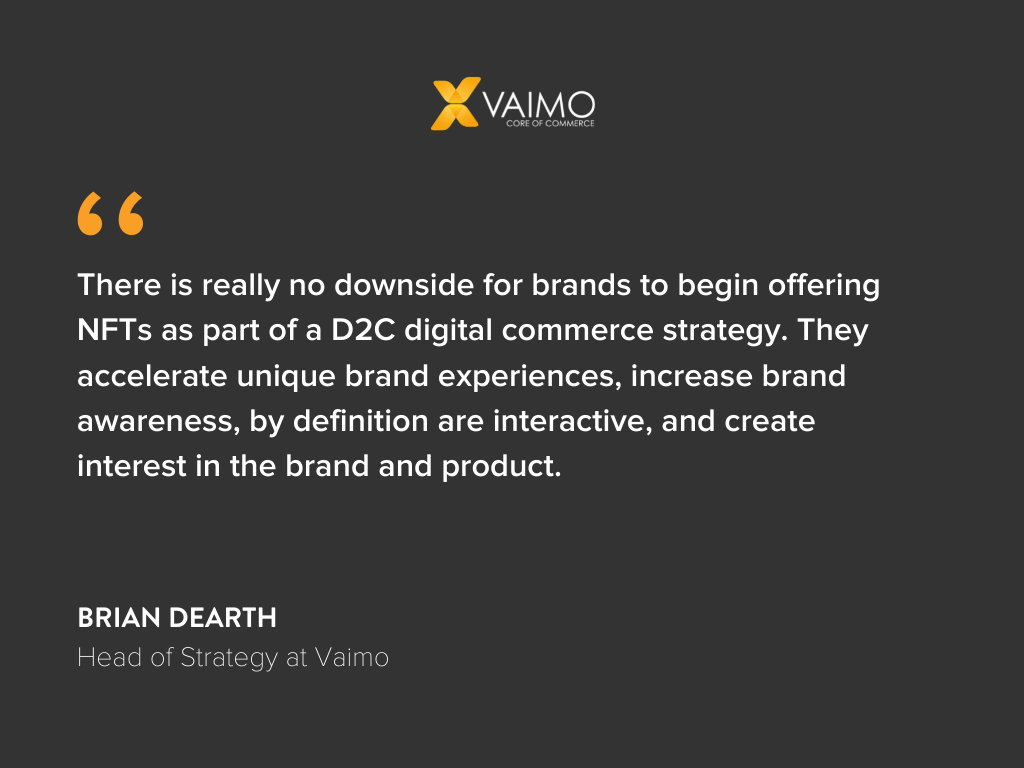Something new and exciting has been happening in the digital world. Perhaps you read about how the Nyan Cat sold as a unique piece of crypto art for $580,000. Or that a tweet from Twitter CEO Jack Dorsey sold for $2.5 million. Suddenly people are paying astronomic amounts for content that anyone can already view on the internet. So, what’s going on?
NFTs, that’s what’s going on. Non-Fungible Tokens.
And yes, initially, it can be a bit tricky to wrap your mind around this concept. But once you understand it and understand the potential it holds in ecommerce, endless possibilities open up. So let’s dive in, shall we?
What is NFT (Non-Fungible Token)?
NFT is an abbreviation of Non-Fungible Token. But the meaning of that is not exactly intuitive either, so let’s explore what it means.
The best way to understand this new phenomenon is to consider a monetary asset. A monetary asset is a fungible token in that it is an exchangeable asset that can be traded for another asset of the same value. So, for example, a $10 bill would be a fungible token, as it can be traded for ten $1 bills, and you’d still have the exact same value.
So what is a Non-Fungible Token, then? Well, let’s say your $10 bill is somehow unique. Let’s say, for example, that it carries the autograph of a celebrity. Suddenly it’s not exchangeable with any other $10 bill. It has become a unique product. Now it’s a Non-Fungible Token (NFT)
NFTs can’t be exchanged for an equivalent value, and like any investment, their value fluctuates in relation to increasing or decreasing demand. However, unlike your $10 bill, NFTs are not physical items; they’re entirely digital.
Related reading: Digital Commerce Business Models—The Current Landscape
NFT Art and Crypto Art Explained
The first examples of digital Non-Fungible Tokens were created through a project called CRYPTOPUNKS. Here, users can sell, buy and store tens of thousands of unique collectible characters, and the proof of ownership is held on the Ethereum Blockchain.
For digital artists, the NFT concept actually solves a critical problem. The value of art depends on many factors like authenticity, age, and the number of owners. Therefore, it makes excellent sense to store unique digital art as an NFT on Blockchain. Digital artists often struggle with proving the authenticity of their work, and the use of Blockchain and NFT’s can help solve this. With Blockchain and NFT’s, artists can upload their art to special websites that add proof of these details to the Blockchain.
Why Are NFT Art and Crypto Art Valuable?
In art, digital representations of art have always been precisely that—reproductions or representations. The original artwork would hang in a museum. And even if you get to, let’s say, The Louvre, you can’t get particularly close to the Mona Lisa. You can’t touch it. You can’t zoom in. You can’t see the various x-ray shots that have been taken.
With digital photography, video, and digital art, it’s the other way around. A print will always be a lesser experience than the digital version. You can’t zoom in on a print, the paper eventually deteriorates, and the print resolution can never match that of 5K monitors. The physical version of a piece of digital artwork is inevitably a limited version of the digital original.
Related reading: Anticipate Disruption With a Digital Experience Strategy
|
Want more advice on this topic? |
Who Is Buying NFT Art and Crypto Art?
There are two main groups of consumers shopping on NFT art sites, and they’re motivated by a very different set of values. On the one hand, there are the art enthusiasts and collectors. These are the people who may love a specific artist’s work or a particular theme or genre. It can be someone who collects paintings of puppies, clips of players from their favorite team, or hats for their Roblox character. Enthusiasts are drawn to the NFT of their preference for the personal value they derive from possessing it, and not for the monetary value.
On the other hand, there are the investors who buy and sell NTFs to make a profit. We’ve all heard the tales of NFT artwork that has sold for millions of dollars, whether we understand it or not. An investor knows that certain pieces will be of great value because of scarcity, originality, ties to a real-life incident and who knows what in the future.
Collectors need authentication but self-validate. Investors need both authentication and outside validation. Authentication has always proven tricky and matures over time as technology and techniques improve. Entire professional fields are built around this crucial part of the validation chain. But for both enthusiasts and investors, the technological trends ahead will change how we perceive art and ownership.
NFT Art Sites and the Opportunities For Creators
There are definitely some unprecedented opportunities for creators and vendors in this new realm. At its most basic level, there is the opportunity to present your creation to an audience, whether through a specific topic-specific channel like TopShot or other NFT marketplaces.
This means artists have the unique ability to self-market their work without the traditional middle-man in the art dealership ecosphere. Artists can control the quantity and visibility of their pieces and can gain in popularity and value quicker than in conventional art launches. Artists in the past had no way of knowing after the original sale where their piece would end up, but with a digital trail, an artist can make sure that when their work makes money for an investor, it makes money for them too.
NFT Art Sites and the Opportunities for Ecommerce Merchants
So how can a brand that sells traditional physical goods make NFTs part of their offering?
We can look to a few creative examples and apply the same logic to the ecommerce of the future. Nike was early to jump on the NFT train by patenting what they call “CryptoKicks.” It’s a system for releasing digital footwear that entails linking physical shoes to virtual versions that can be sold, traded, or stored in an online blockchain “locker.” The brand also envisioned the potential for “breeding” two pairs of digital shoes to create novel “shoe offspring,” whose origins would be tracked on a blockchain, a type of distributed digital ledger.
Imagine the opportunity to breed footwear and turn around and sell your creation on the marketplace as a collectible—all feeding the marketing, social presence, and clout of the Nike brand while making them money at the same time. If brands want to take advantage of the NFT market, they will have to present creative, collectible (or investment) pieces that take advantage of NFTs as a revenue stream. Allowing your customers to become part of the creative process can be one way to do that.

Soon, ecommerce platforms will probably offer a simple plug-in for an NFT channel. What could your brand do to leverage that? The possibilities are limitless. But it can also be as simple as finding an innovative creator to collaborate with, to create digital products that never even have to exist physically to fuel your growth and market presence.
The TopShot revenue stream, where people buy and sell videos of NBA highlights, has been estimated to be one of the top 5 revenue streams in the NBA this year. This is somewhat mind-blowing, considering that it didn’t exist two years ago. Very few revenue strategies see potential ROI as fast, but your brand will need a savvy and original approach to compete in the NFT market.
Related reading: 5 Things to Plan For in Global Ecommerce Development
How Vaimo Can help
At Vaimo, we’re constantly thinking about strategies to help our clients build new revenue channels while complimenting and even furthering their current, traditional streams. NFTs are no exception. We always advise brands to look internally at the people who are already passionate about their products and message because they’re often brimming with ideas. And, we are accustomed to teasing out those creative juices in our initial workshops with clients, both current and new.
As always, the key to getting ahead is getting started. Pieces that you create and offer through NFT art sites and marketplaces can increase in value almost immediately if you strike the right chord. We’d love to help you ideate and get started – get in touch with our team of experts to explore the opportunities!








